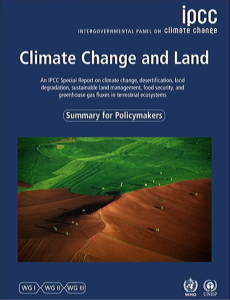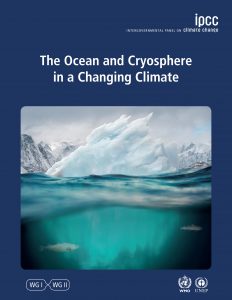The IPCC  (Intergovernmental Panel on Climate Change) published a special report on climate change and land systems (SRCCL) in August 2019. It shows the interaction between climate, ecosystems and land use.
(Intergovernmental Panel on Climate Change) published a special report on climate change and land systems (SRCCL) in August 2019. It shows the interaction between climate, ecosystems and land use.
Resulting in the demand of a rapid change in global land use and land management. The goal must be a sustainable agriculture and forestry combined with a climate-friendly diet. Agriculture, forestry and other land uses are considered to be significant sources of greenhouse gas (GHG) emissions. They account for around 23% of net anthropogenic GHG emissions.
The report warns of the irrevocable loss of ecosystems, whose soils and vegetation act a major GHG sink. These ecosystems store approximately 11.2 GtCO2 per year, which accounts for 29% of global CO2 emissions. However, due to climate change and the difficulty to predict changes, it is uncertain whether this value will last. All scenarios that aim to limit global warming to a maximum of 1.5 or 2 degree Celsius require a global change in land use. Therefore, combinations of afforestation, reforestation, reduced deforestation and the use of bioenergy are needed.
Coastal ecosystems such as mangrove forests, swamps and seagrass beds are referred as important carbon sinks. The loss of these ecosystems results in significant C release (0,15 – 1.02 GtC per year) (Pendleton et al., 2012). Reverse, reducing negative interventions in these ecosystems may contribute to a reduction in CO2 emissions of 0.11 – 2.25 GtCO2 equivalent per year by 2050 (Pendleton et al., 2012; Griscom et al., 2017; Howard et al., 2017; Hawken et al., 2017). Similarly, the restoration of mangrove forests due to re-wetting can reduce the release of 0.07 GtCO2 per year (Crooks et al., 2011). Thus, between 0.02 – 0.84 GtCO2 per year can again be stored in their biomass and soil (Griscom et al., 2017).
The report clearly indicates that some options for action can produce immediate effects, while others take decades to reach measurable results. Conserving ecosystems with high levels of stored carbon – such as mangroves, fenlands and forests – has an immediate impact. Renaturation, afforestation and reforestation, as well as restoration of these ecosystems and the recovery of degraded soils, will, however, take much longer to make a contribution to climate change mitigation. The conservation of today’s ecosystems is therefore the most efficient and easiest option for action.
Therefore, it is necessary to protect today’s ecosystems, prevent their destruction and foster their conservation!
 The recently published special report on the ocean and cryosphere in a changing climate (SROCC) focuses on consequences for ecosystems and people as well as challenges and opportunities for action. For example, restoration of coastal ecosystems such as mangroves, salt marshes and seagrass beds is considered for mitigating climate change. These can reduce around 0.5% of global emissions through carbon uptake and storage per year. The carbon storage below ground can reach up to 1.000 tC per hectare, which is much higher than in most terrestrial ecosystems. Likewise, they are an important coastal defense. Today’s flood damage could be reduced by > 15% annually (Beck et al., 2016; Narayan et al., 2017). It also points out, that these measures also contribute to improving water quality and promoting biodiversity and fishery yields.
The recently published special report on the ocean and cryosphere in a changing climate (SROCC) focuses on consequences for ecosystems and people as well as challenges and opportunities for action. For example, restoration of coastal ecosystems such as mangroves, salt marshes and seagrass beds is considered for mitigating climate change. These can reduce around 0.5% of global emissions through carbon uptake and storage per year. The carbon storage below ground can reach up to 1.000 tC per hectare, which is much higher than in most terrestrial ecosystems. Likewise, they are an important coastal defense. Today’s flood damage could be reduced by > 15% annually (Beck et al., 2016; Narayan et al., 2017). It also points out, that these measures also contribute to improving water quality and promoting biodiversity and fishery yields.
The severe human interventions that affect these ecosystems are causing them to lose their ability to adapt to climate change and provide ecosystem services. Coastal ecosystems are affected by a combination of factors – such as sea-level rise, other climate-related changes in the ocean, and negative impacts of human activities on land and sea. Accordingly, targeted human intervention and conservation can improve the adaptability of natural systems to climate change, reduce carbon emissions, and thus contribute to climate adaptation. The cost of restoring and maintaining coastal habitats depends on various factors – such as the environment, habitat type and project conditions. In general, the costs are lowest for mangrove forests (Bilkovic, 2017).
Floods, storms and floods associated with climate change put coastal and island communities increasingly under risk. Especially low-lying coastal areas (less than 10 m above sea level) are densely populated and therefore particularly exposed to the danger of the ocean. All possible coastal protection measures have their limits. However, ecosystems such as mangroves, salt and seagrass beds can help to reduce the risks and impacts of climate change.